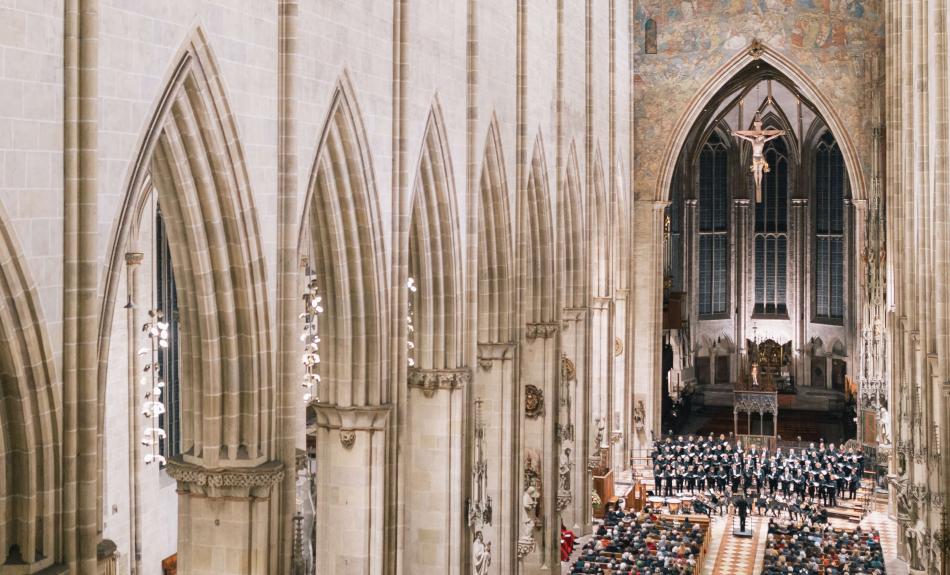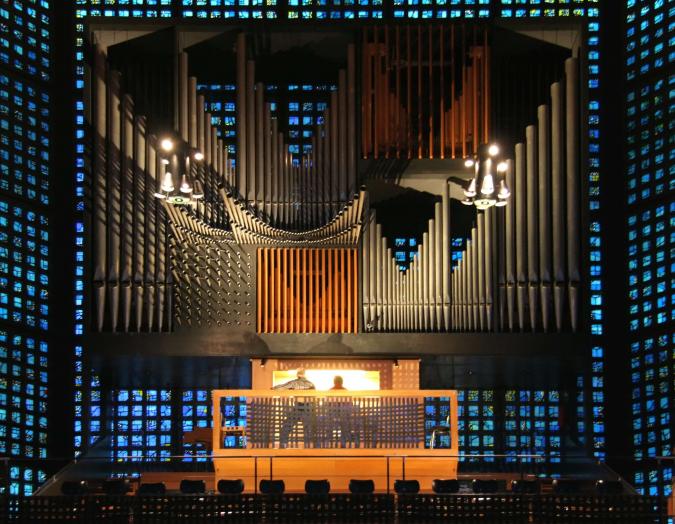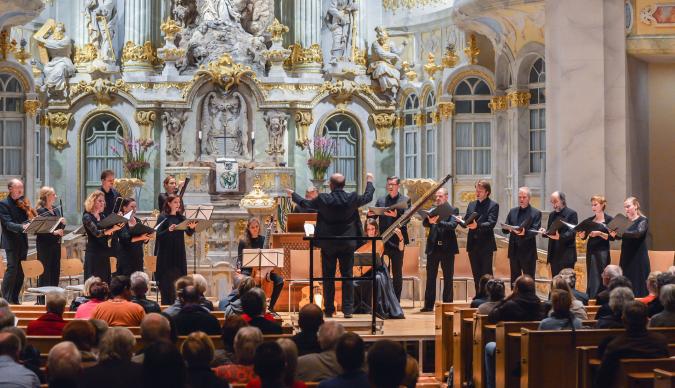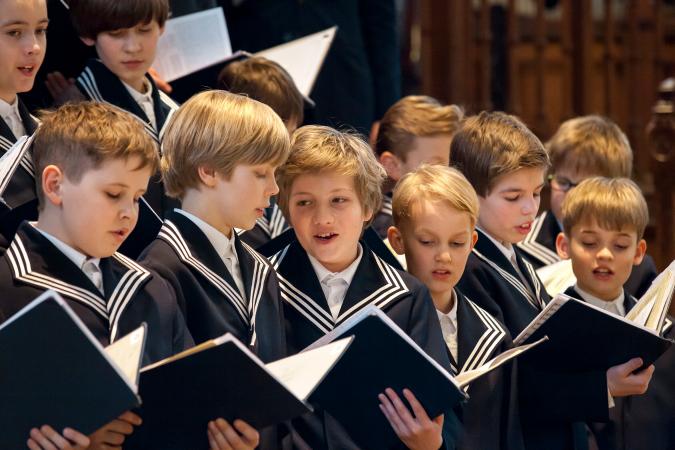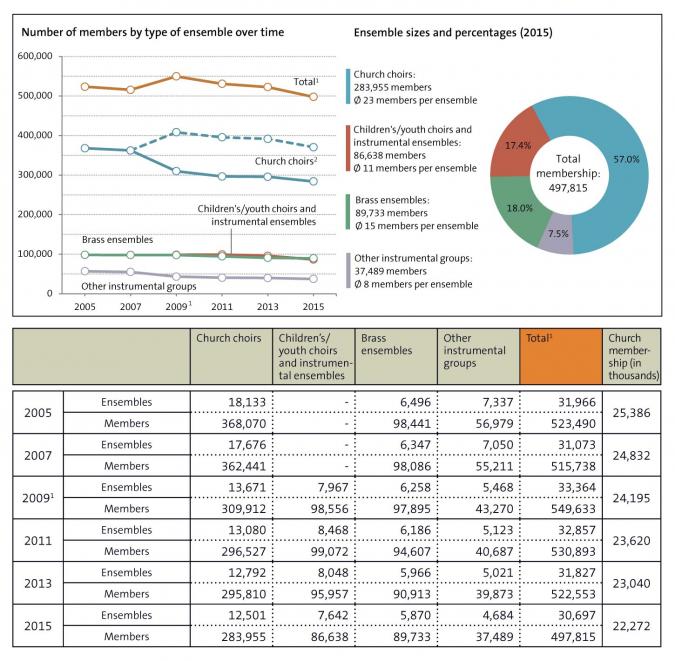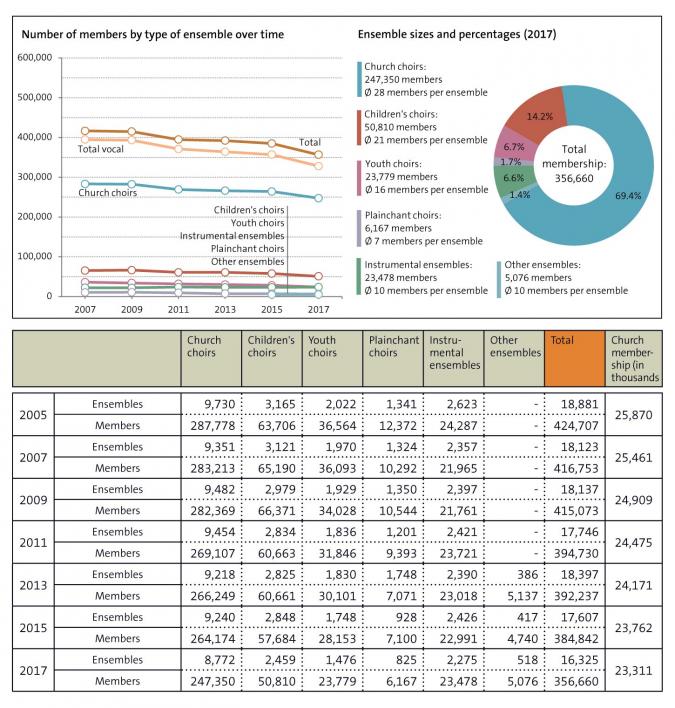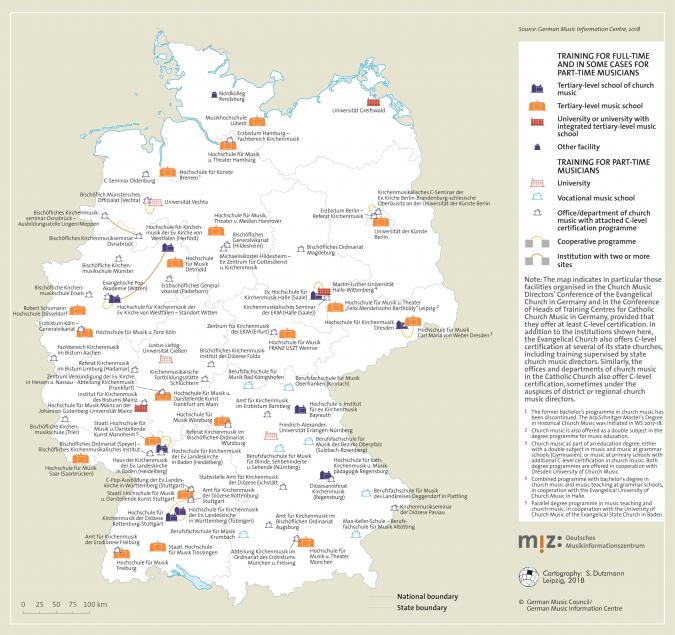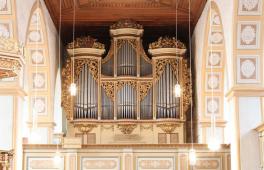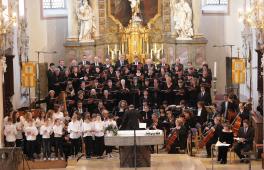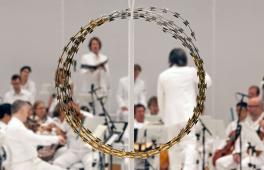‘Church and music’ is a combination of two words with a long, variegated and, on the whole, convoluted history. Neither of them can be fully understood without the other. A ‘church without music’ would lack crucial avenues of expression for Biblical Christian faith, whether the music is vocal or instrumental, liturgical or concertante, professional or amateur. Conversely, anyone trying to imagine ‘music without church’ would not only have to dismiss fabled places of performance, each with its own characteristic music – from the Sistine Chapel in the Catholic Vatican to the Thomaskirche and Nikolaikirche in Protestant Leipzig, not to mention the ecumenical church of the Taizé Community. They would also have to dismiss the church musician’s profession, the countless inspirations, the myriad com missions and the highly interesting and exciting debates hidden in that unassuming conjunction ‘and’. All of this applies not only to church music but also, albeit ‘in different keys’, to the larger complex of ‘music in religion’, for music also plays a distinctive role in the Orthodox churches, in Judaism and in Islam. [1]
No less essential to this complex of topics is the fact that churches function as musical bridges to many areas of human culture. ‘Church music is, at one and the same time, a proclamation of faith and a cultural experience’, [2] as when oratorio performances bring concert audiences closer to works of sacred music, with their usually Biblical themes. Since December 2017 Germany’s tradition of organ building and organ music has entered the UNESCO list of mankind’s intangible cultural heritage, where it stands alongside the famous Christmas carol ‘Silent Night’ and the score of Bach’s B-minor Mass.
Variety of sounds and reflections
Church music is home to many different sounds and timbres, from peals of bells to congregational singing of hymns ancient and modern, from organ music and Gregorian chant to the polyphonic singing of church, youth and children’s choirs, all the way to new hymns in the styles of sacred pop, gospel music and hit tunes. More recent additions include ‘praise and worship’, with meditative and faith-enhancing congregational hymns of the sort practiced in Pentecostal circles and special forms of church worship (doxology services, ‘night fever’ services). [3] More over, alongside composition and performance, instrumental improvisation has come to play a large role in liturgical and concertante church music, and latterly vocal improvisation as well.
Since time immemorial these multifarious sounds have attracted a wealth of theological and aesthetic reflections. Theologians and composers often describe the impact of church singing and instrumental performance with references to insights and scenes from the Old and New Testaments. [4] Theological arguments are marshalled to standardise music in the church: which styles or instruments are appropriate for sacred music, and how can church music be distinguished from secular music, assuming the distinction is relevant at all?
The field becomes still more complex when we consider not only Christianity but other religions and their music. Solemn recitation and unaccompanied monophony, as a ritual ‘embodiment’ of sacred texts and cult passages, seem to exist everywhere, whether in Jewish psalmody, recitations from the Koran or the chanting of Buddhist monks. Also common to all religions is the notion that sacred music does not pursue virtuosity for its own sake, but stands in the service of faith or ritual. Many religions share the tension between musical innovation (the use of instruments, polyphony, counterpoint and so forth) and its regulation for religious purposes. Another antithesis – ascetic limitation of musical resources vs ecstatic virtuosic enhancement – can be equally potent.
Church worship as the heart of church music
The most important task of all Christian church music is to celebrate the church service. This both necessitates and makes possible a vast array of liturgical forms, spatial concepts, vocal and instrumental scorings, stylistic predilections (depending on the era concerned) and, not least of all, levels of musical difficulty. It thus seems advisable, when speaking of music in church services, to use the plural form: ‘musics’. Flanking this central liturgical function are two other areas: the educational activities of church music (from vocal work with children to senior citizens’ choirs) and the many concerts and recitals that might take place in a church.
Concert life and sacred music
Today much of the church repertoire is present in the form of concerts. Organ music, although primarily heard inside churches, is also regularly performed in concert halls during concert series that have been firmly established for decades and are valued by a large audience. It is not only church musicians who perform great works of sacred vocal music – Bach’s settings of the Passion, Handel’s Messiah or the Masses of Mozart, Beethoven and Bruckner: they often feature on the programmes of oratorio choirs and vocal ensembles, sometimes even with choreography, whether in churches, concert halls or music theatres. Similarly, sound record ings and radio broadcasts help church music and sacred music of every era and denomination to be present today as never before. There is even a growing interest in church music at international festivals. Since 2012 the Salzburg Festival has opened with an ‘Ouverture Spirituelle’, not least to promote a dialogue with music of the world’s religions: Judaism in 2012, Buddhism in 2013 and Islam in 2014 (the theme in 2019 was ‘Lacrimae’). The Festival of European Church Music, established in Schwäbisch Gmünd as long ago as 1989, awards the annual European Church Music Prize. Other well-known festivals in this area are the Fürth Days of Church Music (since 1964), the International Organ Week in Nuremberg (Musica Sacra, since 1951) and the Ecumenical Church Music Festival in Cologne (since 1997).
Ecumenical consensus and denominational accents
Today a broad ecumenical consensus reigns in every area of church music. This applies in particular to the repertoire: Mozart Masses are heard in Protestant churches, Schütz motets in Catholic services. Yet denominational differences remain, beginning with the understanding of church space. To Catholics, the consecrated church interior merits a special dignity that restricts its use and impedes the performance of purely ‘secular’ music, even in concerts. In contrast, the Protestant understanding of church space tends to be functional in essence and permits a broader range of musical uses, even events completely unrelated to church and worship
The heart of church music in the Lutheran tradition is to proclaim the message of the Bible in the medium of sound. This is evident, for example, in Martin Luther’s chorales, which seek to ‘add spice’ to the gospels. Their common hymnological de nominator is, to quote the words of his hymn Vom Himmel hoch, ‘whereof I now will say and sing’. The Protestant tradition of church music, culminating in the works of Johann Sebastian Bach, is thoroughly beholden to this outlook. There is little distinction made between sacred and secular styles. Especially in recent times, with the celebration of ‘Reformation and Music’ in 2012 [5] during the Reformation Decade, and with the commemoration of ‘500 Years of Martin Luther’s Reformation’ in 2017, public attention was again drawn to the Protestant foundations of church music.
‘The present-day infrastructure of Germany’s church music evolved over centuries, not only in municipalities, but also in monasteries and schools’
On the Catholic side, the rich repertoire for Mass celebrations (liturgy in the strict sense) and the canonical hours (e.g. festive Vesper settings), as well as concerts and musical devotions, was long counterbalanced by a certain unease toward the theological position of music. Since time immemorial music has been considered a gift of God that finds its purpose in praising the Creator. Yet there are limitations: although music makes church worship more beautiful, in terms of canon law it is irrelevant to the validity of worship. Moreover, the evangelising aspect of music, whether in church worship or in concert, has rarely attracted the interest of Catholic theologians. It was not until the Constitution of the Sacred Liturgy was promulgated at the Second Vatican Council (‘Sacrosanctum Concilium’, 1963) that new perspectives were opened and the antagonism between sacred vs secular was set aside in favour of a more integrative and functional viewpoint (‘the Church approves of all forms of true art having the needed qualities, and admits them into divine worship’; Constitution of the Sacred Liturgy, Art. 112). Despite the high value placed on Gregorian chant and classical vocal polyphony, this was a clear statement of commitment to musical diversity.
Despite debates on the essential qualities of liturgical music, the implementation of the liturgical reform of the last council has yet to resolve the tension between appreciation of the church music tradition and active participation in liturgy and music by all worshippers. A more recent proclamation from the German Catholic Bishops’ Conference, the guideline ‘Music in Church outside the Liturgy’, [6] has attracted much attention in ecumenical circles. For the first time it elaborates theological and aesthetic criteria, not for music in church worship, but for ‘music inside the church’.
The two major hymnals in the German language likewise reveal not only ecumenical points in common with regard to church music, but also denominational emphases. The current Lutheran hymnal, Evangelisches Gesangbuch (EG), was published in 14 regional editions between 1993 and 1996. They all have the same main section, ending with Johann Sebastian Bach’s four-part chorale harmonisation of ‘Gloria sei dir gesungen’, whereas the sections that follow differ from region to region. In 2013 the new Catholic Gotteslob was published for Germany, Austria and South Tyrol, replacing the old one of 1975. It is conceived as a prayer book and hymnal that also functions as a spiritual ‘house book’. The initial impression of three million copies was nearly doubled within the space of two years. Many church music initiatives were undertaken to introduce the hymnal: accompanying publications for choruses and bands, church music directors and organists; recordings of all the hymns and songs in the main section by choruses of the Pueri Cantores Association; a ‘hymn of the month’ campaign initiated by the German Liturgical Institute from 2013 to 2015, or in some dioceses until 2018; courses in further education; a single-volume commentary on the hymns with more than 1,300 pages; and much else. [7]
Infrastructure, professional associations and current developments
The present-day infrastructure of Germany’s church music evolved over centuries, not only in municipalities, but also in monasteries and schools (e.g. the choir of Leipzig’s Thomaskirche). There are significant differences depending on each Catholic (arch)diocese or Protestant regional church (Landeskirche). The overall spectrum is virtually measureless, for it includes not only church music but the many musical performances presented inside churches by other concert organisers, from village music clubs and municipal choral societies to professional concert agencies. All of this is important to the self-image of church music: churches wish to be hospitable, but feel obligated to uphold standards of musical and theological quality. Decisions as to what can or cannot be heard in church are therefore generally left to the pastors and music directors concerned.
Especially important for church music is the network of full- and part-time musicians pervading every area of musical work, whether in the city or in the countryside. As a specialist authority, every (arch)diocese or Landeskirche has an office or commissioner of church music responsible for hiring policy, co-ordination, events, quality management and church music editions as well as the training and further education of church musicians and the public image of church music. Several nationwide associations and conferences complete the church music landscape. On the Catholic side, these are primarily:
- the General Cecilian Society of Germany (Allgemeiner Cäcilien-Verband für Deutschland), the umbrella organization since 1868 for Catholic church music, and especially its choruses;
- the German chapter of Pueri Cantores, the international association of children’s and youth choirs, in existence since 1951;
- the Working Committee of the Administrative Bodies and Departments for Church Music in Germany’s Dioceses (Arbeitsgemeinschaft der Ämter und Referate für Kirchenmusik der Diözesen Deutschlands);
- the National Association of Catholic Church Musicians in Germany (Bundesverband katholischer Kirchenmusikerinnen und Kirchenmusiker Deutschlands), representing the inter ests of professional musicians;
- the Conference of Heads of Training Centres for Catholic Church Music in Germany (Konferenz der Leiterinnen und Leiter der Ausbildungsstätten für katholische Kirchenmusik in Deutschland); and
- the European Conference of Catholic Church Music Associations.
On the Protestant side these include:
- the Choral Association of the Evangelical Church in Germany (Chorverband in der Evangelischen Kirche in Deutschland), the umbrella organisation for Protes tant choral work since 1883;
- the Church Music Directors’ Conference of the Evangelical Church in Germany (Direktorenkonferenz Kirchenmusik in der Evangelischen Kirche in Deutschland), for heads of training centres and regional church music directors;
- the Standing Conference for Church Music in the Evangelical Church in Germany (Ständige Konferenz für Kirchenmusik in der Evangelischen Kirche in Deutschland);
- the Union of Evangelical Church Musicians in Germany (Verband evangelischer Kirchenmusikerinnen und Kirchenmusiker in Deutschland), representing professional musicians;
- the Evangelical Brass Service in Germany (Evangelischer Posaunendienst in Deutschland); and
- the European Conference for Evangelical Church Music.
Since around 2010 there have been heated debates on the professional image of church music, particularly regarding remuneration [8] and the training and employment of so-called ‘pop cantors’. On the Protestant side, a branch of popular music has taken hold in the training programmes for C-level certification, with corresponding courses of study at higher education institutes and a Conference of Education in Popular Music. On the Catholic side, a good many bishoprics have created full-time professional positions with accents or emphases on popular music. Since 2017 the Bishopric of Essen has, for example, hired two full-time ‘pop cantors’ who view their area of activity chiefly in nationwide ‘praise and worship’ workshops.
Full- and part-time church musicians
The mainstay of church music are those men and women who practice it on a full-time or part-time basis. Outside of Germany, it is a profession widely regarded as sideline employment. At present, the hiring situation in Germany reveals a convoluted picture that is, all in all, more positive than often assumed. Since 2000 there have been not only layoffs and cutbacks but also transformations of parttime into full-time positions. Although minor positions have indeed been reduced and church membership has considerably declined, the overall number of fulltime equivalents in church music (FTEs, i.e. the total hours of all employees divided by the standard number of hours for full-time employment) has remained largely stable in both denominations for the last ten years (see Fig. 1). At present there are some 1,900 full-time church musicians in the Evangelical Church (ca. 1,600 FTEs) and slightly more than 1,400 in the Catholic Church (ca. 1,300 FTEs). One peculiarity in the Catholic Church is the increase in FTEs between 2007 (1,117) and 2017 (1,331). The main reason for this is the increase of church musicians in congregational and pastoral work, and hence a trend toward more professional church music at the congregational level. This development took place against the backdrop of the merging of previously independent parishes into much larger units, called ‘pastoral care units’. As the ‘pastoral areas’ grew in size, not only did the many existing semiprofessional positions often remain intact, but new fully professional (part-time) positions were created in some localities, with a range of tasks that often included not only artistic and pastoral care but the co-ordination of church music as a whole . However, this development is not entirely positive: such positions, which often cover 50 to 70 per cent of a full-time position, are advertised not only for holders of a bachelor’s degrees but also, in some case, for applicants with C-level certification who are actually qualified only for semi-professional service.
The professional outlook for budding full-time church musicians is currently quite good, for there will be a relatively small number of applicants for the positions that will soon open up owing to retirements. The most urgent problem is the lack of congruity between the number of students and the number of graduates, plus the phenomenon that by far not all graduates of degree programmes in church music apply for full-time positions. Many find attractive alternatives in music education, an option promoted by the possibility of a double degree in both subjects, but one that does not preclude practicing church music part-time on a personal profes sional basis. Today there are already noticeable problems in filling part-time church music positions, and the problems will, in all likelihood, become worse in the near future, so that some of these positions may simply be scrapped for want of suitable applicants. One reason for this is the social uncertainty of such ‘patchwork’ activities in the arts: those who wish to get by with a part-time job and establish a family will be forced to find additional, and by no means guaranteed, sources of income, e.g. through freelance work (heading a chorus, teaching piano or organ, etc.). More sensible might be positions combining both church music and music education, though as yet there has been little experience along these lines. Even so, it is quite difficult to master the work schedules of such double positions.
Given the shortage of full-time church musicians in the medium term, attention must be paid to the sources of motivation for studying church music. For many young people these sources are, above all, qualified piano and organ instruction on the musical side, and a positive identification with the church on the spiritual side, together with social integration within a congregation, e.g. membership in a church or youth choir or, among Catholics, service as an altar boy or altar girl. However, as in all areas of professional music, the decision to become a full-time church musician is often made before finishing high school. In many cases an important role is played in church music by C-level certification, normally obtained between the ages of 15 and 18. In short, promoting young talents is a crucial task in church music, and it should begin with their socialisation, both in music and in church, so as to encourage interested young people individually in every relevant area.
Church music relies on full-time and part-time positions in equal measure. Balancing these two forces is a task of great importance. But even within full-time positions there are many different models, e.g. as regards their supra-regional and local scope. ‘Congregational positions’ are those consisting primarily of organ playing (in church worship, concerts and occasional services such as weddings and funerals) and choral work (church choir, vocal ensemble, children’s and youth groups) within a particular congregation. In ‘mixed positions’, regional activities (teaching for C-level certification, supervising part-time activities, inter-congregational choral projects and so forth) are augmented by parish work at the place of employment. Today, mixed positions seem to be more secure with regard to mean ingful workloads and long-term financing than simple congregational positions, which are widely threatened by declining church attendance and by funding cutbacks in the congregations concerned.
Besides professional and financial resources, special appreciation must be accord ed to volunteer work in church music. Church music has always been reliant on the fact that people of all ages are not only enthusiastic about singing, but assume many responsibilities for choral work as a whole, from serving as choir spokesperson to organising concerts and excursions to distributing posters and handbills. Professionalism and volunteer work are mutually dependent on and complement each other.
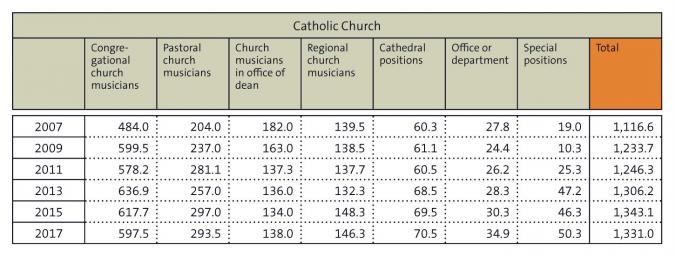
Amateur music-making and youth work
Music-making in church is an important inter-generational factor of amateur music-making in Germany. Some 850,000 people are involved in church choirs and instrumental groups, from Protestant brass ensembles to parish bands as part of church-based youth work (see Fig. 2). Quantitatively, however, a downward trend can be observed in traditional choruses owing to demographic shifts in society and the aging of many church choirs. Since 2002, for example, the number of choruses in the Catholic Church has noticeably dwindled, as has their membership. In recent years the earlier model of the traditional church choir has been augmented with more sophisticated structures, and perhaps rendered obsolete in the long run. Even today a considerable role is played by short-term projects with smaller ad hoc ensembles focusing on a single work or performance.
Considering the wealth of choral concerts sustained by the church, this quantita tive decline seems to go hand in hand with new qualitative tendencies. The church music scene now includes a wide-ranging mixture of people attached to the church and people interested in culture. When it comes to performing Bach’s Christmas Oratorio or Mozart’s Requiem denominational differences among the choristers seem almost immaterial. And yet, despite its cultural attraction and social relevance, the future outlook of church music will continue to depend decisively on positive identification with the church as an institution.
Training and education
Church music is typified by a tight-knit web of full-time, part-time and volunteer participants. A wide range of state-run and church-run educational facilities is available for training full- and part-time musicians. The spectrum extends from state-run tertiary-level Musikhochschulen with church music departments to special institutes of Catholic or Protestant church music to universities with a builtin Musikhochschule, not to mention a few Bavarian vocational schools that offer training in church music (see Fig. 3). Many facilities train students in both Catholic and Protestant church music while others, particularly the church-run institutes, limit the training to a single denomination. For full-time professionals, the former courses of study for A-level and B-level certification in church music have been discontinued and replaced by academic bachelor’s and master’s degrees. Part-time professionals can still obtain C- and D-level certification
Training for C-level certification is the responsibility of the Catholic (arch)dioceses and the Protestant Landeskirchen. As a result, the organisation and contents are set down by the administrative bodies and departments of church music (Catholic) or by the regional cantoral offices (Protestant). The terminology for the type and location of the training varies, and includes such terms as ‘C-level church music training’ and ‘C-level seminar’ all the way to ‘episcopal church music school’ or ‘house of church music’. Based on a framework document adapted to account for regional differences, a degree from these extra-scholastic or extra-vocational training programmes qualifies the holder to practice church music on a part-time basis. The curriculum barely differs from that for full-time employment. To be sure, the demands of the examination suit the special character of training for part-time work, preceded by an aptitude test. Many facilities also offer a D-level certification even less demanding than its C-level counterpart, as well as so-called ‘subarea qualifications’ for programmes involving isolated parts of C-level certification, such as playing the organ or directing the choir or brass ensemble. Today C-level certification is even offered exclusively for pop music. In the meantime C-level and D-level certifications are, for the most part, mutually recognised in an ecumenical spirit. Moreover, an appreciable number of qualified musicians are professionally employed in church music on the side although they have degrees in other musical fields, whether music education, organ (bachelor’s, master’s or performance degree) or, more recently, jazz.
The two- or three-year training programmes for C-level certification, [9] with group or individual lessons and phases of intensive instruction, are initially designed to impart skills and knowledge in their courses of study. But there is an additional networking aspect: young church music students at institutes of higher learning are now recruited primarily from graduates of C-level programmes.
Full-time church musicians are trained at state Musikhochschulen, universities with a built-in Musikhochschule or special schools of church music. The pro grammes cov er eight semesters for a bachelor’s degree and an additional four for a master’s degree. The basic contents and minimum requirements for these studies are set down in framework documents and assume specific form and scope at the institute concerned. As a rule, it is assumed that applicants for a church position will belong to the denomination of the church concerned.
The bachelor’s programme in church music is noteworthy for its broad curriculum: performance of organ literature, liturgical organ playing, choir conducting, voice lessons, piano playing (in some cases jazz piano), choral accompaniment, subjects specific to a denomination (liturgy, theology, plainchant, German liturgical singing, hymnology) and much more. The master’s programme basically builds on this foundation. To quote the framework document, it enables graduates ‘to obtain outstanding artistic and sometimes theoretical and scholarly achievements in the working areas of church music, to conduct technical and administrative supervision and consultation for church music in ecclesiastical districts with offerings for the training and advanced education of full-time and part-time church musicians, to advise church committees in technical matters, and to represent church music in public’.
In the winter semester 2016-17 there were 525 students of church music enrolled at Germany’s institutes of higher music education (see Fig. 1 in the essay ‘Education for Music Professions’). In the long run this represents a stable trend and makes it safe to posit a solid average of some 500 to 600 students each year in the future (with annual deviations). Less stable over the last ten years was the number of graduates, implying that there is a problem in attracting young church musicians. What is wholly unjustified is the accusation, occasionally heard with regard to church music that the Musikhochschulen are turning out graduates ‘in excess of demand’.
Students of church music are encouraged by relevant competitions, prizes and scholarships. Prizes for special artistic or scholarly achievements (e.g. final theses on subjects related to church music) are frequently awarded by the educa tional institutes concerned. Scholarships can be sought from various institutions, includ ing the churches. Successes at competitions entail not only prize money but nationwide attention and, in the best cases, career-enhancing appearances in leading venues or renowned concert series. Of particular interest to young musicians, in addition to the many organ and conducting competitions, are specialist or denominational competitions, e.g. for organ improvisation in church worship (held by the Conference of Heads of Training Centres for Catholic Church Music in Germany) or for voice (the Greifswald Bach Week). The International Composers’ Competition ‘Musica Sacra Nova’ (Cologne) and the New Sacred Music Composers’ Competition (Schwäbisch Gmünd) are worthy of note with regard to the creation of new works of church and sacred music
Remuneration, acceptance, entrance into the workforce
Many students are already active practitioners of church music before and during their studies, which helps them to grow into their later profession. Some take double degrees in music education (usually with organ as main instrument) and church music. This places greater pressure on their studies, as do their extracurricular musical activities in church.
The academic training of full-time church musicians, who will bear educational, pastoral and artistic responsibilities in their daily professional lives, is not always reflected in proper remuneration. Although this topic is currently subject to widespread debate, and although there have been some initial trendsetting breakthroughs, it is only in a few Catholic (arch)dioceses and Protestant Landeskirchen that their remuneration has become comparable to that in the pastoral aca demic professions or in music education. In particular the superior financial sit uation and better working hours in high school teaching (with prospects of receiv ing civil servant status) cause many church music students to decide in favour of the teaching profession after taking their degree and passing their exams. Others see the attraction of church music in its greater artistic freedom and choose it for this reason. Ultimately, the church musician’s profession can best be described as a semi-freelance area made secure by a permanent church position. This freedom offers great musical opportunities, but it also demands the enormous personal commitment typical of freelance professions: cultivating a spirit of invention and experimentation, working together with soloists and ensembles (as well as municipal organisers and schools) and responding to the aesthetic demands of a society in flux, a society whose growing complexity may soon become more important than traditional denominational differences. All of this requires more than musical and artistic preparation for entry into the workforce. For this reason various new models for entering full-time employment as church musicians are currently being debated and, in some cases, put into practice, from year-long internships to week-long crash programmes with joint courses for prospective church musicians and pastoral caregivers.
Fields of tension and future perspective
Today church music faces growing challenges. Occasionally choirs are disband ed while others are newly established. All in all, the number of choristers is declin ing. Except in such ambitious locations as St Peter’s in Cologne or St Martin’s in Kassel, contemporary art music often plays at best a marginal role. Although Germany, taken as a whole, has a rich and diverse landscape for organ music, organ-building projects frequently founder on financial obstacles. The search for part-time church musicians is long and tedious for many congrega tions, and some churches have not held a concert in years. Many of these isolated prob lems are rooted in a lack of awareness of musical quality, a lack as likely to be found in church committees as in pastoral workers.
Finally, two contrary trends are noticeable today. One is a ‘downward spiral’: the declining numbers of church members and church services limit spiritual and finan cial latitude, to the detriment of both the quantity and the quality of church music. Another is an ‘upward spiral’: German churches, though dwindling in member ship yet still well-funded (on an international scale), must focus on their core tasks, which necessarily include church services and hence church music. This area provides not only options for church worship through music but good opportunities for youth work in children’s and youth choirs and instrumental ensembles. Moreover, church concerts continue to reach many who have abandoned other areas of church life.
Church music is an artistic profession that is pursued in a in pastoral context. [10] The artistic vs pastoral tension, being a defining feature, cannot be resolved in favour of one or the other. Rather it must be shaped in a meaningful way, both musically and theolog ically. For professional musicians it is important not to misconstrue the pastoral dimension as a secondary adjunct to their normal activities. Church music can only succeed when its practitioners find their specific place in the interaction of all pastoral professions. On the other hand, many recent job advertisements tend to over emphasise the pastoral aspect, raising the question whether they offer enough leeway for artistic development.
What does church music need to thrive in the future? It requires training that combines artistic excellence with communicative skills. It also requires a delicate balance between the three areas of employment – full-time, part-time and voluntary – lest they fail to interact in a meaningful way. Further, church music needs people who see no conflict between artistic quality and pastoral activity. It also needs attractive positions with varied proportions of regional and congregational responsibility, vocal and instrumental music, education and art, church worship and concerts, classical music and pop. No less important is the inclusion of church music employees in a church's governing body. Church music must solicit sympathy, support and funds from the church, society and individuals, far more so than it has done in recent decades. Not least, its future will depend on its ability to enter a dialogue, an ability that has proved its worth many times in the past.
Footnotes
- See the articles by Konstantin Nikolakopoulos, Jascha Nemtsov and Dorit Klebe.
- Christian Höppner in his introduction to the German Music Information Centre’s web portal ‘Kirchenmusik – Musik in Religionen’.
- Exhaustive account in Matthias Schneider et al., eds., Enzyklopädie der Kirchenmusik in 7 Bänden (Laaber, 2011–18).
- Thomas Schipperges, Musik und Bibel: 111 Figuren und Motive, Themen und Texte, vol. i: Altes Testament, vol. ii: Neues Testament (Kassel, 2009).
- Evangelische Kirche in Deutschland, ed., Reformation und Musik: Themenheft zur Lutherdekade 4 (Hanover, 2012), online at https://www.reformation-und-musik.de/download/2012_themenheft_reformation_und_musik_2auflage.pdf (accessed on 10 July 2018)
- Secretariat of the German Bishops’ Conference, Musik im Kirchenraum außerhalb der Liturgie (Bonn, 2005), online at https://dli.institute/wp/wp-content/uploads/2017/11/ah194.pdf (accessed on 20 July 2018).
- See the Gotteslob portal of the German Liturgical Institute, Trier, online at https://gotteslob.katholisch.de (accessed on 29 August 2018).
- Christoph Bogon, ‘Die tarifliche Situation von evangelischen Kirchenmusikern’, Musik und Kirche, 87/4 (2017), pp. 206-08; Godehard Weithoff, ‘Die Eingruppierung katholischer Kirchenmusiker in Deutschland’, ibid., pp. 210-15.
- As a relatively rare option the Rottenburg-Stuttgart diocese offers a compact one-year residential C degree (Catholic).
- ‘Die kirchenmusikalischen Dienste. Leitlinien zur Erneuerung des kirchenmusikalischen Berufsbildes’, Musica Sacra 111/6 (1991), pp. 535f.
